New Records of Ditylenchus Species from Southern Alberta, Canada
Abstract
1. Introduction
2. Results
2.1. Description of Ditylenchus anchilisposomus (Tarjan) Fortuner [28,40]
2.2. Description of Ditylenchus clarus Thorne and Malek [31]
2.3. Description of Ditylenchus tenuidens Gritsenko [41]
2.4. Description of Ditylenchus valveus Thorne and Malek [31]
2.5. Molecular Characterisation and Phylogeny of the Recovered Ditylenchus Species
3. Discussion
4. Materials and Methods
4.1. Nematode Isolation and Morphological Studies
4.2. DNA Extraction, PCR, and Sequencing
4.3. Phylogenetic Studies
5. Conclusions
Author Contributions
Funding
Institutional Review Board Statement
Informed Consent Statement
Data Availability Statement
Acknowledgments
Conflicts of Interest
References
- Filipjev, I. On the classification of the Tylenchinae. Proc. Helminthol. Soc. Wash. 1936, 3, 80–82. [Google Scholar]
- Nicoll, W. VI. Vermes. Rhabditida. Anguinidae. Zool. Rec. 1935, 72, 105. [Google Scholar]
- Siddiqi, M.R. Tylenchida: Parasites of Plants and Insects; CABI: Wallingford, UK, 2000; Volume 2, p. 833. [Google Scholar]
- Subbotin, S.A.; Madani, M.; Krall, E.; Sturhan, D.; Moens, M. Molecular diagnostics, taxonomy, and phylogeny of the stem nematode Ditylenchus dipsaci species complex based on the sequences of the internal transcribed spacer-rDNA. Phytopathology 2005, 95, 1308–1315. [Google Scholar] [CrossRef] [PubMed]
- Nicol, J.; Turner, S.; Coyne, D.L.; Nijs, L.d.; Hockland, S.; Maafi, Z.T. Current nematode threats to world agriculture. In Genomics and Molecular Genetics of Plant-Nematode Interactions; Springer: Heidelberg, Germany, 2011; pp. 21–44. [Google Scholar]
- Vovlas, N.; Troccoli, A.; Palomares-Rius, J.E.; De Luca, F.; Liébanas, G.; Landa, B.B.; Subbotin, S.A.; Castillo, P. Ditylenchus gigas n. sp. parasitizing broad bean: A new stem nematode singled out from the Ditylenchus dipsaci species complex using a polyphasic approach with molecular phylogeny. Plant Pathol. 2011, 60, 762–775. [Google Scholar] [CrossRef]
- Goodey, J. Ditylenchus myceliophagus n. sp.(Nematoda: Tylenchidae). Nematologica 1958, 3, 91–96. [Google Scholar] [CrossRef]
- Perry, R.N.; Moens, M. Plant Nematology; CABI: Wallingford, UK, 2013. [Google Scholar]
- Zhang, S.; Liu, G.; Janssen, T.; Zhang, S.; Xiao, S.; Li, S.; Couvreur, M.; Bert, W. A new stem nematode associated with peanut pod rot in China: Morphological and molecular characterization of Ditylenchus arachis n. sp.(Nematoda: Anguinidae). Plant Pathol. 2014, 63, 1193–1206. [Google Scholar] [CrossRef]
- Giblin-Davis, R.M.; Erteld, C.; Kanzaki, N.; Ye, W.; Zeng, Y.; Center, B.J. Ditylenchus halictus n. sp.(Nematoda: Anguinidae), an associate of the sweat bee, Halictus sexcinctus (Halictidae), from Germany. Nematology 2010, 12, 891–904. [Google Scholar] [CrossRef]
- Xue, Q.; Slonim, O.; Bucki, P.; Mendel, Z.; Protasov, A.; Golan, O.; Vieira, P.; Miyara, S.B. Diversity and distribution of nematodes associated with bark beetles in Israel. Nematology 2019, 21, 875–886. [Google Scholar] [CrossRef]
- Oliveira, R.D.; Santin, Â.M.; Seni, D.J.; Dietrich, A.; Salazar, L.A.; Subbotin, S.A.; Mundo-Ocampo, M.; Goldenberg, R.; Barreto, R.W. Ditylenchus gallaeformans sp. n.(Tylenchida: Anguinidae)—A neotropical nematode with biocontrol potential against weedy Melastomataceae. Nematology 2013, 15, 179–196. [Google Scholar] [CrossRef]
- Hawn, E. Transmission of bacterial wilt of alfalfa by Ditylenchus dipsaci (Kühn). Nematologica 1963, 9, 65–68. [Google Scholar] [CrossRef]
- Hawn, E. Plant-parasitic nematodes in irrigated soils of Alberta. Can. Plant Dis. Surv. 1973, 53, 29–30. [Google Scholar]
- Moens, M.; Perry, R.N. Migratory plant endoparasitic nematodes: A group rich in contrasts and divergence. Annu. Rev. Phytopathol. 2009, 47, 313–332. [Google Scholar] [CrossRef] [PubMed]
- Hashemi, K.; Karegar, A. Description of Ditylenchus paraparvus n. sp. from Iran with an updated list of Ditylenchus Filipjev, 1936 (Nematoda: Anguinidae). Zootaxa 2019, 4651, 85–113. [Google Scholar] [CrossRef] [PubMed]
- Wendt, K.; Swart, A.; Vrain, T.; Webster, J. Ditylenchus africanus sp. n. from South Africa; a morphological and molecular characterization. Fundam. Appl. Nematol. 1995, 18, 241–250. [Google Scholar]
- Butler, E.J. Diseases of Rice; Superintendent Government Printing: Kolkata, India, 1913. [Google Scholar]
- Thorne, G. Ditylenchus destructor n. sp. the potato rot nematode, and Ditylenchus dipsaci (Kühn, 1857) Filipjev, 1936, the teasel nematode (Nematoda: Tylenchidae). Proc. Helminthol. Soc. Wash. 1945, 12, 27–34. [Google Scholar]
- Kühn, J. Über das Vorkommen von Anguillulen in erkrankten Blüthenköpfen von Dipsacus fullonum L. Z. Für Wiss. Zool. 1857, 9, 129–137. [Google Scholar]
- Madani, M.; Tenuta, M.; Chizhov, V.N.; Subbotin, S.A. Diagnostics of stem and bulb nematodes, Ditylenchus weischeri and D. dipsaci (Nematoda: Anguinidae), using PCR with species-specific primers. Can. J. Plant Pathol. 2015, 37, 212–220. [Google Scholar] [CrossRef]
- Yaghoubi, A.; Pourjam, E.; Ye, W.; Castillo, P.; Pedram, M. Description and molecular phylogeny of Ditylenchus gilanicus n. sp.(Nematoda: Anguinidae) from northern forests of Iran. Eur. J. Plant Pathol. 2018, 152, 735–746. [Google Scholar] [CrossRef]
- Arriola, Í.A.; dos Santos Isaias, R.M. Extending the knowledge on the histological patterns of leaf galls induced by Ditylenchus gallaeformans (Nematoda) on Miconia (Melastomataceae) hosts. Flora 2021, 274, 151753. [Google Scholar] [CrossRef]
- Castillo, P. Ditylenchus Gigas (Giant Stem and Bulb Nematode). CABI Compend Datasets 2022, 1–12. Available online: HTTPS://WWW.CABI.ORG/ISC/DATASHEET/118252 (accessed on 22 November 2022).
- Prasad, J.; Varaprasad, K. Ufra nematode, Ditylenchus angustus is seed borne! Crop Prot. 2002, 21, 75–76. [Google Scholar] [CrossRef]
- Hajihassani, A.; Tenuta, M.; Gulden, R.H. Host preference and seedborne transmission of Ditylenchus weischeri and D. dipsaci on select pulse and non-pulse crops grown in the Canadian Prairies. Plant Dis. 2016, 100, 1087–1092. [Google Scholar] [CrossRef]
- Brzeski, M.W. Review of the genus Ditylenchus filipjev, 1936 (Nematoda: Anguinidae). Rev. Nématologie 1991, 14, 9–59. [Google Scholar]
- Fortuner, R. On the genus Dilylenchus Filipjev, 1936 (Nernatoda: Tylenchida). Rev. Nematol. 1982, 5, 17–38. [Google Scholar]
- Anderson, R. An emended description of Ditylenchus valveus Thorne &Malek, 1968 and description of D. filimus n. sp.(Nematoda: Tylenchidae) from mushroom compost in Canada. Can. J. Zool. 1983, 61, 2319–2323. [Google Scholar]
- Anderson, R.; Mulvey, R. Description, relationships, and host symptoms of Ditylenchus dryadis n. sp.(Nematoda: Tylenchidae) from the Canadian High Arctic, a transitional species of gall-forming parasite attacking Dryas integrifolia M. Vahl. Can. J. Zool. 1980, 58, 363–368. [Google Scholar] [CrossRef]
- Thorne, G.; Malek, R.B. Nematodes of the Northern Great Plains: Part 1 Tylenchida [Nemata Secernentra]. South Dak. Agric. Exp. Stn. Tech. Bull. 1968, 31, 1–111. [Google Scholar]
- Chizhov, V.N.; Borisov, B.A.; Subbotin, S.A. A new stem nematode, Ditylenchus weischeri sp. n.(Nematoda: Tylenchida), a parasite of Cirsium arvense (L.) Scop. in the central region of the non-chernozem zone of Russia. Russ. J. Nematol. 2010, 18, 95–102. [Google Scholar]
- Yu, Q.; Ye, W.; Badiss, A.; Sun, F. Description of Ditylenchus dipsaci (Kuhn, 1857) Filipjev, 1936 (Nematoda: Anguinidae) infesting garlic in Ontario, Canada. Int. J. Nematol. 2010, 20, 185–192. [Google Scholar]
- Yu, Q.; Zaida, M.; Hughes, B.; Celetti, M. Discovery of potato rot nematode, Ditylenchus destructor, infesting garlic in Ontario, Canada. Plant Dis. 2012, 96, 297. [Google Scholar] [CrossRef] [PubMed]
- Tenuta, M.; Madani, M.; Briar, S.; Molina, O.; Gulden, R.; Subbotin, S.A. Occurrence of Ditylenchus weischeri and not D. dipsaci in field pea harvest samples and Cirsium arvense in the Canadian Prairies. J. Nematol. 2014, 46, 376–384. [Google Scholar] [PubMed]
- Poirier, S.; Dauphinais, N.; Van Der Heyden, H.; Véronneau, P.-Y.; Bélair, G.; Gravel, V.; Mimee, B. Host range and genetic characterization of Ditylenchus dipsaci populations from eastern Canada. Plant Dis. 2019, 103, 456–460. [Google Scholar] [CrossRef] [PubMed]
- Munawar, M.; Yevtushenko, D.P.; Palomares-Rius, J.E.; Castillo, P. Species diversity of pin nematodes (Paratylenchus spp.) from potato growing regions of southern Alberta, Canada. Plants 2021, 10, 188. [Google Scholar] [CrossRef] [PubMed]
- Munawar, M.; Yevtushenko, D.P.; Castillo, P. Integrative taxonomy, distribution, and host associations of Geocenamus brevidens and Quinisulcius capitatus and from southern Alberta, Canada. J. Nematol. 2021, 53, 1–15. [Google Scholar] [CrossRef] [PubMed]
- Munawar, M.; Castillo, P.; Yevtushenko, D.P. Description of Filenchus species from agroecosystem of southern Alberta, Canada. Agronomy 2022, 12, 690. [Google Scholar] [CrossRef]
- Tarjan, A. A new genus, Pseudhalenchus (Tylenchinae: Nematoda), with descriptions of two new species. Proc. Helminthol. Soc. Wash. 1958, 25, 20–25. [Google Scholar]
- Gritsenko, V. Ditylenchus tenuidens n. sp. and Aphelenchoides curiolis n. sp.(Nematoda, Tylenchidae and Aphelenchoididae) from Kirgizia. Zool. Zhurnal 1971, 50, 1402–1405. [Google Scholar]
- Cobb, M.V. New nemic genera and species, with taxonomic notes. J. Parasitol. 1933, 20, 81–94. [Google Scholar] [CrossRef]
- Bastian, H.C., II. Monograph on the Anguillulidae, or Free Nematoids, Marine, Land, and Freshwater; with Descriptions of 100 New Species. Trans. Linn. Soc. Lond. 1865, 25, 73–184. [Google Scholar] [CrossRef]
- Thorne, G. Principles of Nematology; McGraw Hill Book Company: New York, NY, USA, 1961; Volume 93, p. 53. [Google Scholar]
- Mirshekari, K.; Abdollahi, M. Description of two known species of Ditylenchus, collected from wheat fields of Boyer-Ahmad and Dena regions, Kohgiluyeh and Boyer-Ahmad Province. Iran. J. Plant Pathol. 2015, 51, 269–275. [Google Scholar]
- Brzeski, M.W. The effect of host on morphology and population increase of Ditylenchus myceliophagus Goodey (Nematoda: Tylenchidae). Bull. L’academie Pol. Sciences. Cl. II. Ser. Sci. Biol. 1967, 15, 147–149. [Google Scholar]
- Evans, A.; Fisher, J. The effect of environment on nematode morphometrics. Comparison of Ditylenchus myceliophagus and D. destructor. Nematologica 1970, 16, 113–122. [Google Scholar] [CrossRef]
- Karani, H.M.; Eskandari, A.; Ghaderi, R.; Heydari, R.; Miraeez, E. Morphological characterisation of a new and two known species of Ditylenchus Filipjev, 1936 (Nematoda: Anguinidae) from Iran. Zootaxa 2017, 4216, 355–368. [Google Scholar] [CrossRef]
- Steiner, G.; Buhrer, E.M. Aphelenchoides xylophilus n. sp., a nematode associated with blue-stain and other fungi in timber. J. Agric. Res. 1934, 48, 949–951. [Google Scholar]
- Nickle, W.R. A taxonomic review of the genera of the Aphelenchoidea (Fuchs, 1937) Thorne, 1949 (Nematoda: Tylenchida). J. Nematol. 1970, 2, 375–392. [Google Scholar]
- Ritzema Bos, J. De bloemkoolziekte der aardbeien, veroorzaakt door Aphelenchus fragariae nov. spec. Voorloopige Meded. Maanblad Nat. 1890, 16, 107–117. [Google Scholar]
- Christie, J. Recent observations on the strawberry dwarf neaiatode in Massachusetts. Plant Dis. Rep. 1932, 16, 113–114. [Google Scholar]
- Siddiqi, M.R. Four new species in the sub-family Tylenchinae (Nematoda) from North India. Z. Fur Parasitenkd. 1963, 23, 397–404. [Google Scholar] [CrossRef] [PubMed]
- Zhao, L.; Ye, W.; Maria, M.; Pedram, M.; Gu, J. Xiphinema japonicum n. sp.(Nematoda: Longidorinae) from the Rhizosphere of Japanese Podocarpus macrophyllus (Thunb.), a cryptic species related to Xiphinema bakeri Williams, 1961. J. Nematol. 2017, 49, 404–417. [Google Scholar] [CrossRef] [PubMed]
- Lehman, P.S. Dissemination of phytoparasitic nematodes. Nematol. Circ. 1994, 208. [Google Scholar]
- Forge, T.A.; Larney, F.J.; Kawchuk, L.M.; Pearson, D.C.; Koch, C.; Blackshaw, R.E. Crop rotation effects on Pratylenchus neglectus populations in the root zone of irrigated potatoes in southern Alberta. Can. J. Plant Pathol. 2015, 37, 363–368. [Google Scholar] [CrossRef]
- Orley, L. Az anguillulidák magánrajza (Monographie der Anguilluliden). Természetrajzi Füzetek Bp. 1880, 4, 16–150. [Google Scholar]
- Jones, J.T.; Haegeman, A.; Danchin, E.G.; Gaur, H.S.; Helder, J.; Jones, M.G.; Kikuchi, T.; Manzanilla-López, R.; Palomares-Rius, J.E.; Wesemael, W.M. Top 10 plant-parasitic nematodes in molecular plant pathology. Mol. Plant Pathol. 2013, 14, 946–961. [Google Scholar] [CrossRef]
- Somasekhar, N.; Prasad, J.S. Plant–nematode interactions: Consequences of climate change. In Crop Stress and Its Management: Perspectives and Strategies; Springer: Dordrecht, The Netherlands, 2012; pp. 547–564. [Google Scholar]
- Skwiercz, A.T.; Kornobis, F.W.; Winiszewska, G.; Przybylska, A.; Obrępalska-Stęplowska, A.; Gawlak, M.; Subbotin, S.A. Ditylenchus laurae sp. n.(Tylenchida: Anguinidae) from Poland–a new species of the D. dipsaci complex associated with a water plant, Potamogeton perfoliatus L. Nematology 2017, 19, 197–209. [Google Scholar] [CrossRef]
- Jenkins, W. A rapid centrifugal-flotation technique for separating nematodes from soil. Plant Dis. Report. 1964, 48, 692. [Google Scholar]
- Seinhorst, J. A rapid method for the transfer of nematodes from fixative to anhydrous glycerin. Nematologica 1959, 4, 67–69. [Google Scholar] [CrossRef]
- De Grisse, A.T. Redescription ou Modifications de Quelques Technique Utilis dan L’etude des Nematodes Phytoparasitaires; Mededlingen Rijksfaculteit der Landbouwwetenschappen Gent: Stockholm, Sweden, 1969; Volume 34. [Google Scholar]
- Maria, M.; Powers, T.; Tian, Z.; Zheng, J. Distribution and description of criconematids from Hangzhou, Zhejiang Province, China. J. Nematol. 2018, 50, 183–206. [Google Scholar]
- Holterman, M.; van der Wurff, A.; van den Elsen, S.; van Megen, H.; Bongers, T.; Holovachov, O.; Bakker, J.; Helder, J. Phylum-wide analysis of SSU rDNA reveals deep phylogenetic relationships among nematodes and accelerated evolution toward crown clades. Mol. Biol. Evol. 2006, 23, 1792–1800. [Google Scholar] [CrossRef]
- De Ley, P.; Felix, M.-A.; Frisse, L.; Nadler, S.; Sternberg, P.; Thomas, W.K. Molecular and morphological characterisation of two reproductively isolated species with mirror-image anatomy (Nematoda: Cephalobidae). Nematology 1999, 1, 591–612. [Google Scholar] [CrossRef]
- Ferris, V.; Ferris, J.; Faghihi, J. Variation in spacer ribosomal DNA in some cyst-forming species of plant parasitic nematodes. Fundam. Appl. Nematol. 1993, 16, 177–184. [Google Scholar]
- Curran, J.; Driver, F.; Ballard, J.; Milner, R. Phylogeny of Metarhizium: Analysis of ribosomal DNA sequence data. Mycol. Res. 1994, 98, 547–552. [Google Scholar] [CrossRef]
- Katoh, K.; Rozewicki, J.; Yamada, K.D. MAFFT online service: Multiple sequence alignment, interactive sequence choice and visualization. Brief. Bioinform. 2019, 20, 1160–1166. [Google Scholar] [CrossRef] [PubMed]
- Hall, T.A. BioEdit: A user-friendly biological sequence alignment editor and analysis program for Windows 95/98/NT. In Nucleic Acids Symposium Series; Information Retrieval Ltd.: London, UK, 1999; Volume 41, pp. 95–98. [Google Scholar]
- Tan, G.; Muffato, M.; Ledergerber, C.; Herrero, J.; Goldman, N.; Gil, M.; Dessimoz, C. Current methods for automated filtering of multiple sequence alignments frequently worsen single-gene phylogenetic inference. Syst. Biol. 2015, 64, 778–791. [Google Scholar] [CrossRef] [PubMed]
- Darriba, D.; Taboada, G.L.; Doallo, R.; Posada, D. jModelTest 2: More models, new heuristics and parallel computing. Nat. Methods 2012, 9, 772. [Google Scholar] [CrossRef] [PubMed]
- Rambaut, A. FigTree v1. 4.2, A Graphical Viewer of Phylogenetic Trees. 2014. Available online: http://tree.bio.ed.ac.uk/software/figtree/right angle bracket (accessed on 28 November 2022).

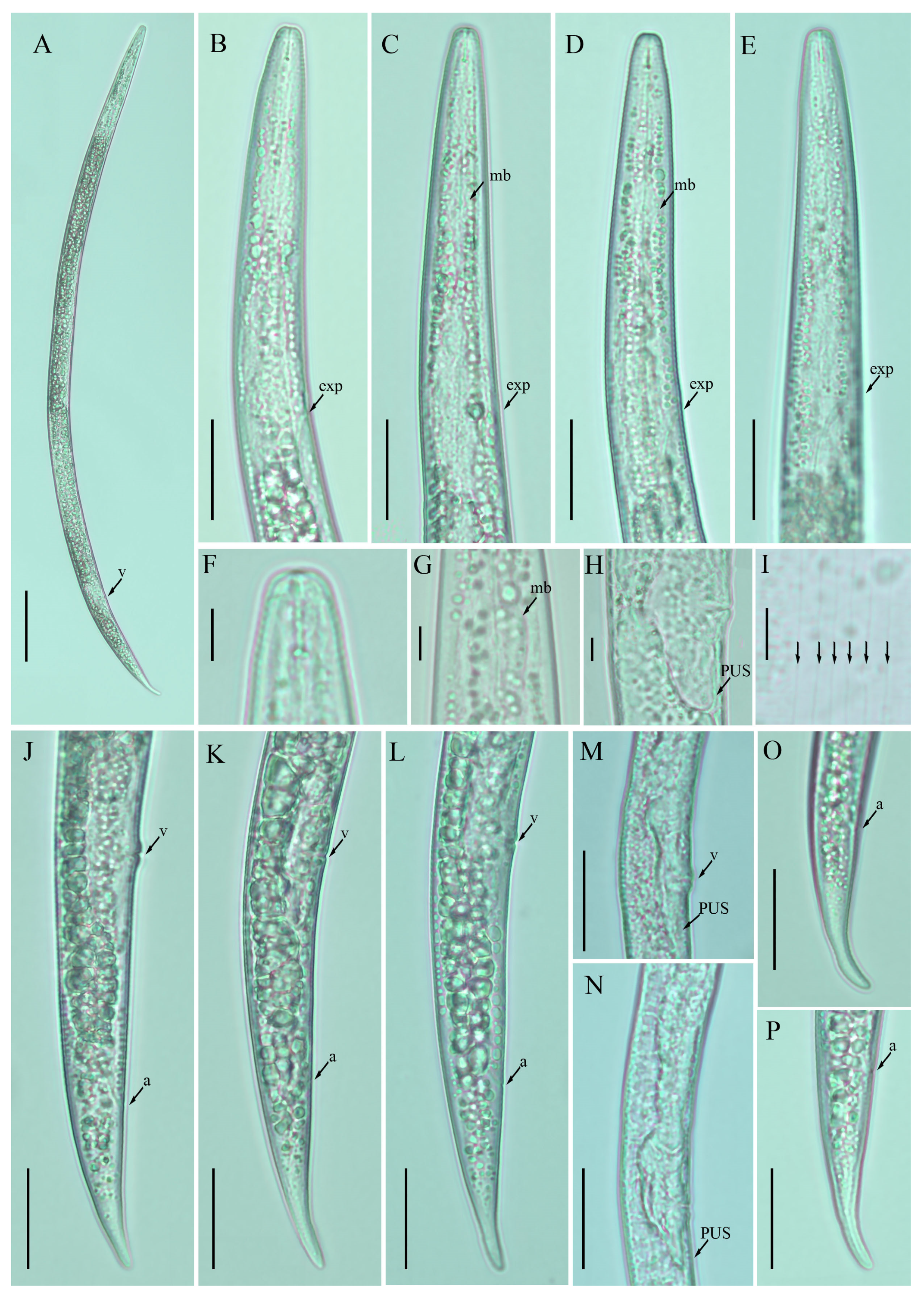
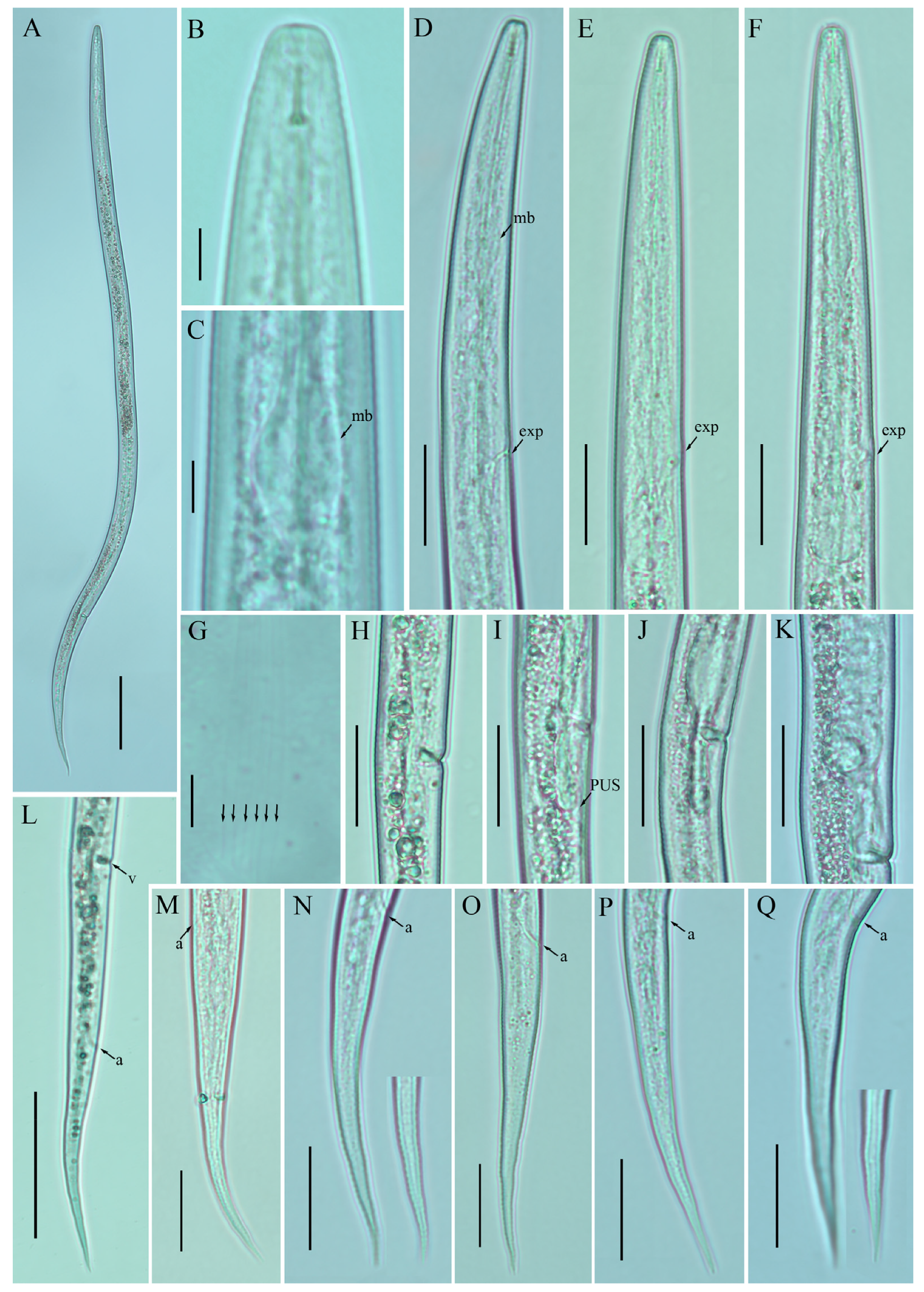
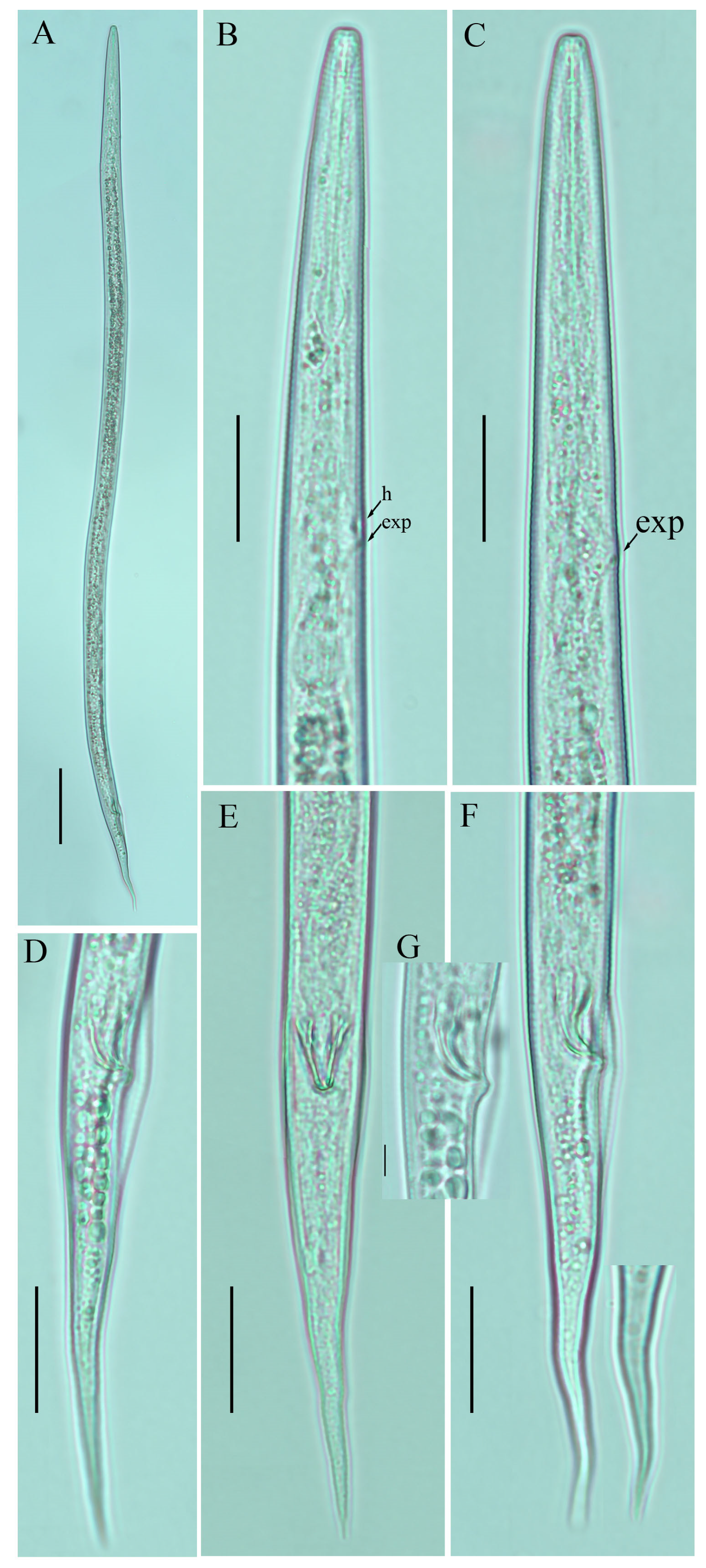


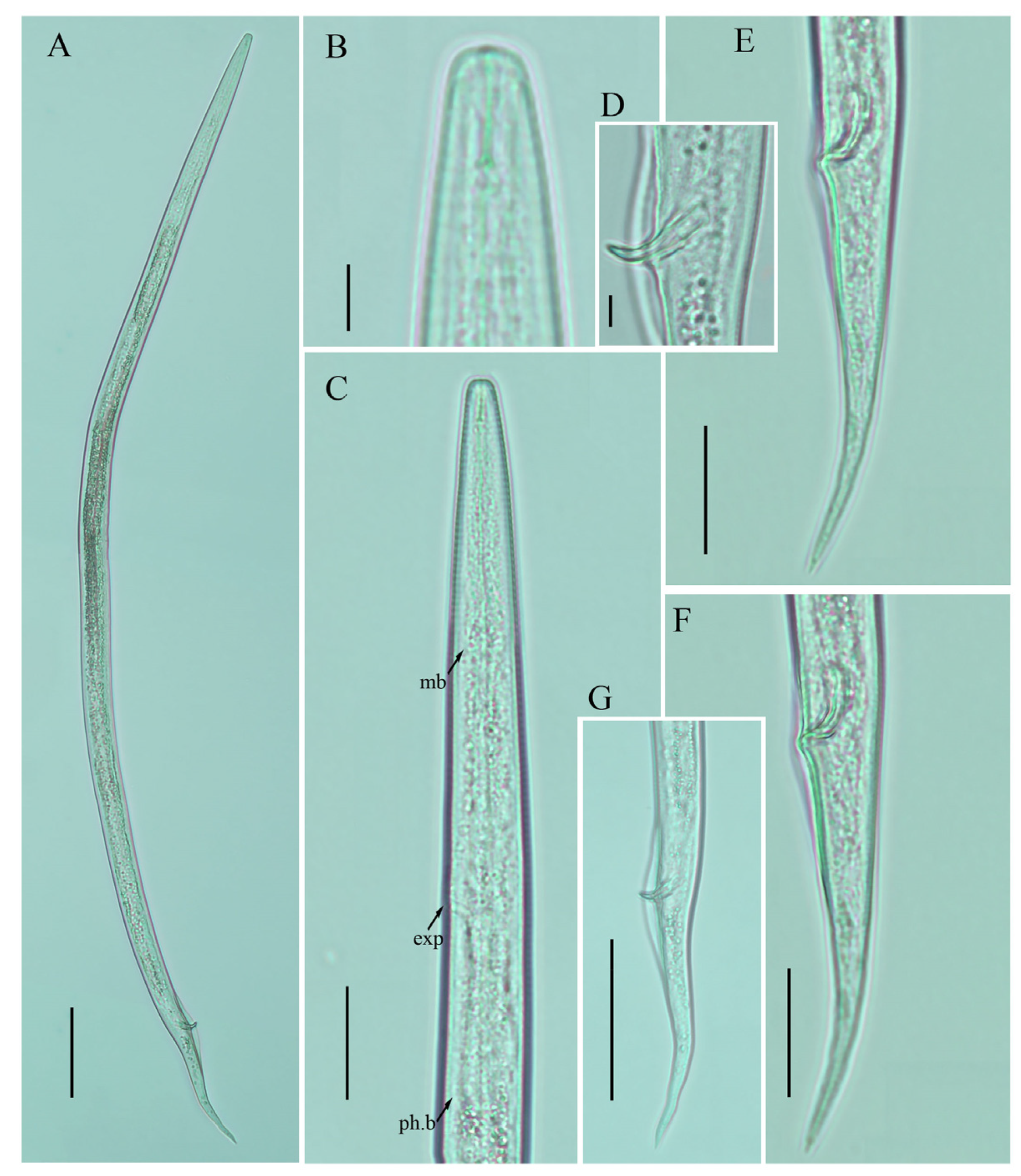
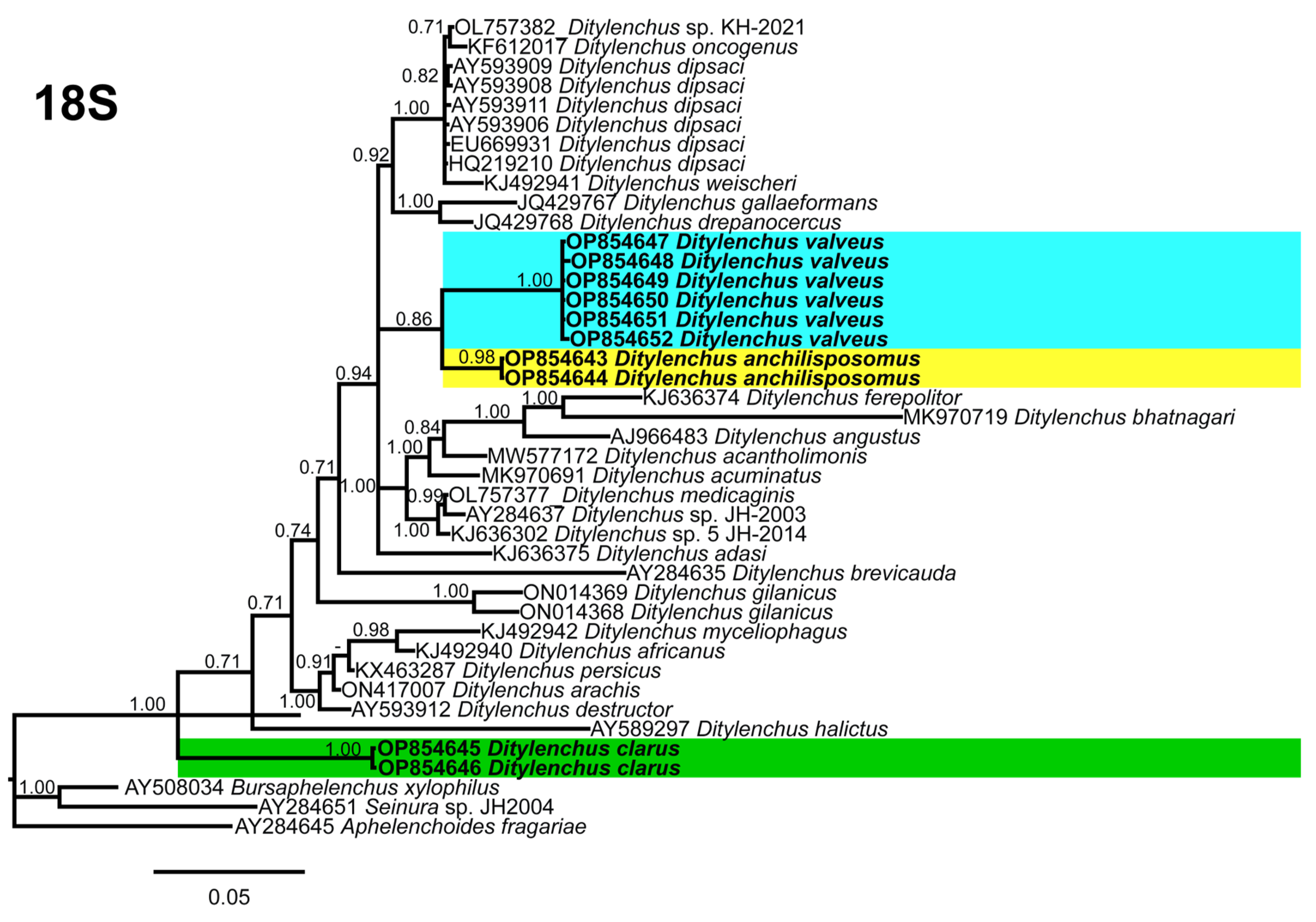

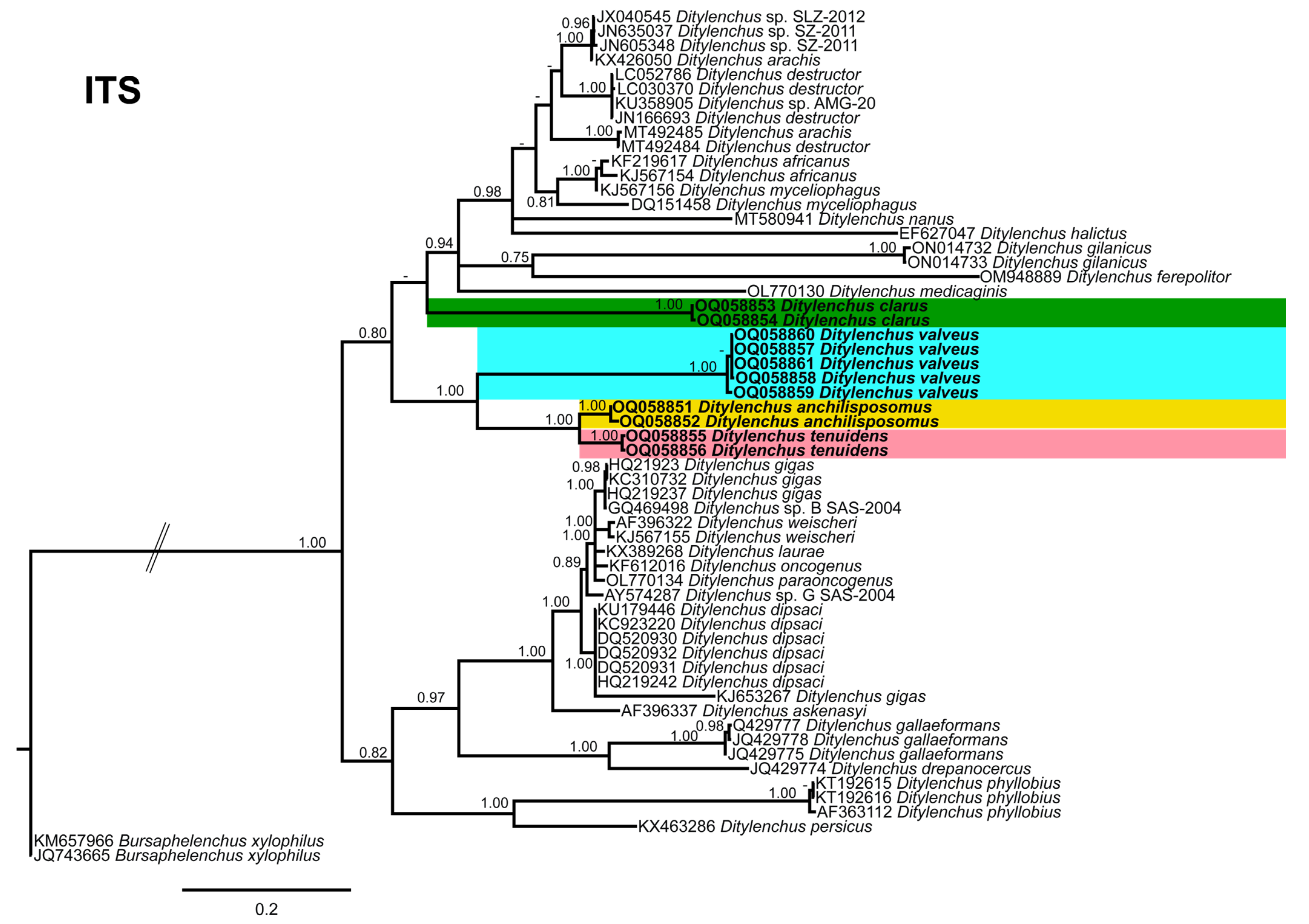
| This Study | Tarjan [40] | Thorne and Malek [31] | Hashemi and Karegar [16] | |
|---|---|---|---|---|
| Location | Southern Alberta, Canada | California, USA | Nebraska, USA | Southern Provinces, Iran |
| Habitat | No-till field, previously planted with potatoes | Grass rhizosphere | – | – |
| n | 15 | 19 | 1 | 7 |
| Body length | 706.0 ± 65.3 (600.0–815.0) | 624 (487–728) | 640 | 660 (615–708) |
| a | 40.0 ± 2.4 (36.0–43.0) | 33.9 (30.6–39.9) | 31 | 42.1 (37.3–46.9) |
| b | 6.0 ± 0.6 (4.7–7.3) | 4.7 (4.1–5.1) | 6.2 | 5.7 (4.4–6.5) |
| c | 13.0 ± 0.7 (12.0–14.0) | 12.3 (11.1–13.2) | 13 | 11.9 (10.6–13.2) |
| c’ | 4.5 ± 0.5 (3.6–5.5) | – | – | 5.3 (4.8–5.7) |
| MB | 37.5 ± 2.9 (31.5–42.0) | – | – | |
| V | 82.0 ± 1.2 (81.0–85.0) | 81 (78–83) | 82 | 80.1 (77.5–82.0) |
| V’ | 92.0 ± 0.4 (91.5–93.0) | – | – | 87.5 (85.3–88.7) |
| Lip height | 2.0 ± 0.2 (2.0–3.0) | – | – | – |
| Lip width | 6.0 ± 0.5 (5.5–7.0) | – | – | – |
| Stylet length | 8.6 ± 0.5 (8.0–9.5) | 8.8 (7.6–10.8) | 10 | 8.4 (7.5–9) |
| Median bulb length | 14.0 ± 1.4 (12.0–17.0) | – | – | – |
| Median bulb width | 6.5 ± 0.5 (6.0–7.5) | – | – | – |
| Distance from anterior end to secretory–excretory pore | 90.0 ± 4.5 (83.0–97.0) | 81 (74–95) | – | – |
| Distance from secretory–excretory pore to hemizonid | 3.0 ± 0.2 (3.0–4.0) | – | – | – |
| Pharynx length | 118.0 ± 8.4 (102.0–128.0) | – | – | 117 (107-139) |
| Max body diam. | 18.0 ± 2.0 (15.0–21.0) | – | – | – |
| Vulva body width (VBW) | 16.5 ± 1.6 (15.0–20.0) | – | – | – |
| Postvulval uterine sac (PUS) length | 31.0 ± 2.4 (25.0–35.0) | 32 (20–41) | – | – |
| PUS/VBW | 1.9 ± 0.2 (1.4–2.1) | – | – | 2.0 (1.4–2.6) |
| PUS/V–A% | 45.0 ± 6.5 (33.0–54.0) | – | – | 40.4 (29.2–46.2) |
| Distance from vulva to tail terminus | 125.0 ± 9.4 (111.0–140.0) | – | – | – |
| Distance from vulva to anus (V–A) | 69.0 ± 6.7 (60.0–82.0) | – | – | – |
| Anal body width (ABW) | 12.0 ± 1.6 (10.0–15.0) | – | – | – |
| Tail length | 55.5 ± 4.8 (50.0–68.0) | – | – | 55.8 (51–66) |
| This Study | Thorne and Malek [31] | |
|---|---|---|
| Location | Southern Alberta, Canada | South Dakota, USA |
| Habitat | Amaranthus sp. | – |
| n | 20 | 1 |
| Body length | 540.0 ± 44.0 (452.0–610.0) | 700 |
| a | 29.0 ± 2.6 (25.0–36.0) | 27 |
| b | 6.0 ± 0.5 (5.0–7.0) | 5.3 |
| c | 12.5 ± 0.9 (11.0–14.0) | 12.8 |
| c’ | 3.7 ± 0.3 (3.3–4.2) | – |
| MB | 37.0 ± 1.3 (35.0–39.0) | – |
| V | 82.0 ± 1.2 (79.0–85.0) | 79 |
| V’ | 92.0 ± 0.6 (91.0–93.0) | – |
| Lip height | 6.2 ± 0.5 (5.0–7.0) | – |
| Lip width | 2.5 ± 0.2 (2.0–3.0) | – |
| Stylet length | 7.1 ± 0.1 (7.0–7.5) | 10 |
| Median bulb length | 10.0 ± 1.2 (8.0–11.6) | – |
| Median bulb width | 6.3 ± 0.6 (5.0–7.5) | – |
| Distance from anterior end to secretory–excretory pore | 71.0 ± 2.8 (66.0–76.0) | – |
| Pharynx length | 88.0 ± 4.8 (78.0–95.0) | – |
| Max body diam. | 18.5 ± 1.5 (16.0–21.0) | – |
| Vulva body width (VBW) | 17.0 ± 1.5 (15.0–19.5) | – |
| Postvulval uterine sac (PUS) length | 17.0 ± 1.7 (15.0–21.0) | – |
| PUS/VBW | 1.0 ± 0.1 (0.8–1.3) | – |
| PUS/V–A% | 33.0 ± 3.5 (27.5–38.8) | – |
| Distance from vulva to tail terminus | 95.5 ± 8.5 (79.0–112.0) | – |
| Distance from vulva to anus (V–A) | 52.0 ± 6.2 (40.0–64.0) | – |
| Anal body width | 12.0 ± 1.0 (10.0–13.8) | – |
| Tail length | 43.0 ± 3.0 (39.0–48.0) | – |
| Character | Female | Male |
|---|---|---|
| n | 14 | 7 |
| Body length | 854.0 ± 116.1 (702.0–1091.0) | 804.0 ± 55.4 (714.0–864.0) |
| a | 42.0 ± 2.5 (38.0–47.0) | 45.0 ± 6.3 (36.0–53.5) |
| b | 6.0 ± 0.7 (5.0–7.6) | 6.0 ± 0.5 (5.0–6.5) |
| c | 9.0 ± 0.9 (8.0–11.0) | 9.0 ± 0.9 (8.0–11.0) |
| c’ | 7.0 ± 0.8 (5.4–8.5) | 6.0 ± 0.6 (6.0–7.0) |
| MB | 40.0 ± 2.4 (36.0–46.0) | 40.0 ± 1.8 (37.0–41.0) |
| V | 79.0 ± 2.1 (74.0–82.5) | – |
| V’ | 89.0 ± 1.0 (80.3–90.0) | – |
| Lip height | 3.0 ± 0.8 (2.0–5.5) | 6.0 ± 0.4 (5.0–6.5) |
| Lip width | 6.0 ± 0.5 (5.5–7.5) | 2.3 ± 0.3 (2.0–3.0) |
| Stylet length | 8.4 ± 0.5 (8.0–9.5) | 8.4 ± 0.3 (8.0–9.0) |
| Median bulb length | 14.0 ± 1.5 (11.0–17.0) | 12.6 ± 1.6 (11.0–15.0) |
| Median bulb width | 9.0 ± 1.0 (8.0–10.5) | 8.0 ± 1.3 (7.0–10.0) |
| Distance from anterior end to secretory–excretory pore | 105.0 ± 7.1 (90.0–112.0) | 103.0 ± 2.1 (101.0–106.0) |
| Distance from secretory–excretory pore to hemizonid | 3.6 ± 0.3 (3.0–4.0) | 3.7 ± 0.3 (3.2–4.0) |
| Pharynx length | 139.0 ± 7.0 (126.0–148.0) | 138.0 ± 5.0 (132.0–146.0) |
| Max body diam. | 20.0 ± 2.4 (17.0–24.0) | 18.0 ± 2.6 (15.0–21.0) |
| Vulva body width (VBW) | 18.0 ± 1.3 (16.0–21.0) | – |
| Postvulval uterine sac (PUS) length | 22.0 ± 3.2 (18.0–28.0) | – |
| PUS/VBW | 1.2 ± 0.2 (1.0–1.5) | – |
| PUS/V–A% | 28.0 ± 3.7 (17.5–32.0) | – |
| Distance from vulva to tail terminus | 175.0 ± 24.3 (137.0–212.0) | – |
| Distance from vulva to anus (V–A) | 82.0 ± 17.0 (60.0–119.0) | – |
| Anal/cloacal body width | 13.5 ± 1.4 (11.0–16.0) | 14.0 ± 1.1 (13.0–16.0) |
| Tail length | 94.0 ± 9.9 (75.0–107.0) | 89.0 ± 7.2 (75.0–96.0) |
| Spicule length | – | 17.0 ± 1.9 (15.0–20.0) |
| Gubernaculum length | – | 6.0 ± 0.7 (5.0–6.5) |
| This Study | Gritsenko [41] | Brzeski [27] | Mirshekari and Abdollahi [45] | ||||
|---|---|---|---|---|---|---|---|
| Location | Southern Alberta, Canada | Kyrgyzstan | Bialowieska National Park, Poland | Sweden | Northern Province, Iran | ||
| Habitat | No-till field previously planted with grains | Potato, winter wheat | – | Coniferous litter | Moss | Moss | Vegetables, wheat |
| n | 14 | – | 8 | 10 a | 4 | 11 a | 5 |
| Body length | 854.0 (702–1091) | – | 646 (591–677) | 550–853 | 665 (625–732) | 552–770 | 644 (531–738) |
| a | 42.0 (38–47) | – | 35 (29–40) | 31–44 | 37 (32–42) | 34–42 | 42 (38.6–46.2) |
| b | 6.0 (5.0–7.6) | – | 4.6–5.0 | 4.1–6.8 | 4.9 (4.6–5.1) | 4.4–4.9 | 6.1 (5.2–7.2) |
| c | 9.0 (8.0–11.0) | 9.0–12.9 | 10.3 (9.5–12.7) | 10.1–11.6 | 10.7 (10–11.2) | 9.7–12.2 | 12 (10.8–13.9) |
| c’ | 7.0 (5.4–8.5) | 4.1–6.8 | 5.5 (4.4–6.0) | 4.6–6.0 | 5.8 (5.2–6.8) | 4.7–6.2 | 5.1 (4.4–6.0) |
| MB | 40.0 (36–46) | – | 36–41 | 38–42 | 39–41 | 36–39 | 45.8 (37.5–55.2) |
| V | 79.0 (74–82.5) | 76–82 | 77–79 | 75–82 | 77–79 | 76–79 | 79.9 (74.3–84) |
| V’ | 89.0 (80.3–90) | – | 85–88 | 77–87 | 85-86 | 84–87 | – |
| Stylet length | 8.4 (8.0–9.5) | 7–9 | 8 | 7.0–8.5 | 8 | 7.5–8.5 | 7.8 (7.5–8.1) |
| Distance from anterior end to secretory–excretory pore | 105.0 (90–112) | – | 93 (87–97) | 81–103 | 91–101 | 85–93 | 88.3 (79–98) |
| Pharynx length | 139.0 (126–148) | – | 134 (128–141) | 111–135 | 136 (129–145) | 126–146 | 106 (90–120) |
| Postvulval uterine sac (PUS) length | 22.0 (18–28) | 18–37 | 25.1 (15–32.5) | ||||
| Tail length | 94.0 (75–107) | 64 (53–69) | 47–95 | 63 (56–73) | 62 | 43.8 (49.3–60) | |
| Character | Females | Males |
|---|---|---|
| n | 45 | 5 |
| Body length | 976.0 ± 64.4 (863.0–1097.0) | 810.0 ± 7.1 (800.0–819.0) |
| a | 40.5 ± 4.3 (34.0–54.5) | 44.0 ± 4.7 (38.5–50.0) |
| b | 7.0 ± 0.5 (5.7–8.1) | 6.2 ± 0.1 (6.1–6.4) |
| c | 10.5 ± 0.8 (8.0–12.0) | 9.5 ± 1.1 (9.0–11.5) |
| c’ | 6.0 ± 0.5 (5.2–7.7) | 6.5 ± 1.2 (5.0–8.0) |
| MB | 37.0 ± 2.3 (29.5–42.0) | 38.7 ± 0.4 (38.0–39.0) |
| V/T | 82.0 ± 1.2 (79.0–84.0) | 62.0 ± 3.9 (59.0–65.0) |
| V’ | 91.0 ± 0.8 (88.0–92.0) | – |
| Lip height | 2.4 ± 0.2 (2.0–3.0) | 2.1 ± 0.1 (2.0–2.5) |
| Lip width | 5.9 ± 0.4 (5.0–7.0) | 5.4 ± 0.2 (5.0–6.0) |
| Stylet length | 8.2 ± 0.3 (7.0–9.0) | 7.7 ± 0.4 (7.0–8.0) |
| Median bulb length | 13.5 ± 1.4 (11.0–16.0) | 12.0 ± 2.0 (10.0–14.0) |
| Median bulb width | 7.5 ± 0.7 (6.0–9.0) | 6.7 ± 0.6 (6.0–8.0) |
| Distance from anterior end to secretory–excretory pore | 114.0 ± 6.3 (101.131.0) | 103.0 ± 2.1 (100.0–105.0) |
| Distance from secretory–excretory pore to hemizonid | 3.8 ± 0.6 (2.6–5.0) | 3.5 ± 0.7 (3.0–4.0) |
| Pharynx length | 143 ± 9.7 (130.0–170.0) | 130.4 ± 1.8 (128.0–133.0) |
| Max body diam. | 24.5 ± 2.4 (20.0–30.0) | 18.4 ± 2.1 (16.0–21.0) |
| Vulva body width (VBW) | 22.0 ± 1.5 (19.0–25.0 | – |
| Postvulval uterine sac (PUS) length | 20.5 ± 2.7 (15.0–26.0) | – |
| PUS/VBW | 0.9 ± 0.1 (0.6–1.2) | – |
| PUS/V–A% | 25.5 ± 3.6 (19.0–37.0) | – |
| Distance from vulva to tail terminus | 175.0 ± 10.3 (143.0–194.0) | – |
| Distance from vulva to anus (V–A) | 81.0 ± 6.3 (63.0–94.0) | – |
| Anal body width (ABW) | 15.7 ± 1.1 (13.5–18.0) | – |
| Cloacal body width | – | 13.6 ± 2.7 (11.0–18.0) |
| Tail length | 93.0 ± 5.4 (80.0–108.0) | 85.8 ± 8.5 (71.0–92.0) |
| Spicule length | – | 20.3 ± 1.0 (19.0–21.0) |
| Gubernaculum length | – | 6.2 ± 0.3 (6.0–6.5) |
| This Study | Thorne and Malek [31] | Anderson [29] | Brzeski [27] | Karani et al. [48] | Hashemi and Karegar [16] | ||
|---|---|---|---|---|---|---|---|
| Location | Southern Alberta, Canada | South Dakota, USA | Manitoba, Canada | Oltarzew, Poland | Varna, Bulgaria | Northern Province, Iran | Southern Provinces, Iran |
| Habitat | No-till field, previously planted with barley | Plowed field | Mushroom compost | Cultivated loamy soil | Rhizosphere of unidentified bush | Olive tree rhizosphere | – |
| n | 45 | 1 | 6 | 7 | 5 | 9 | 9 |
| Body length | 976.0 (863.0–1097.0) | 900 | 883 (736–1088) | 910 (831–998) | 677 (621–725) | 970 (919–1037) | 739 (638–907) |
| a | 40.5 (34.0–54.5) | 36 | 42 (37–45) | 42 (35–52) | 41 (35–46) | 32.5 (25–36.5) | 38.3 (29.3–51.7) |
| b | 7.0 (5.7–8.1) | 7.4 | 7.3 (5.3–8.9) | 6.8 (6.0–7.8) | 5.5 (5.0–5.8) | 6.2 (5.7–6.9) | 6.1 (5.2–8.0) |
| c | 10.5 (8.0–12.0) | 12 | 9.6 (8.4–10.9) | 9.9 (9.6–10.3) | 11.4 (10.2–14.1) | 11.1 (9.0–12.0) | 11.5 (9.8–14.4) |
| c’ | 6.0 (5.2–7.7) | – | 7.5 (5.8–8.8) | 7.0 (6.8–7.2) | 5.7 (5.0–6.3) | 5.2 (4.5–6.4) | 5.5 (4.5–7.4) |
| MB | 37.0 (29.5–42.0) | – | – | 37 (35–38) | – | 36.0 (34.0–37.7) | 80.4 (79.0–82.7) |
| V | 82.0 (79.0–84.0) | 81 | 81 (80–82) | 80–82 | 79–82 | 79.1 (76–81) | – |
| Stylet length | 8.2 (7.0–9.0) | 12 | 8 (7–9) | 7.0–7.5 | 7.5 (7–8) | 7.7 (7–8) | 7.2 (7–8) |
| Pharynx length | 143 (130.0–170.0) | – | 116–139 | 135 (128–144) | 122 (118–131) | 157 (146–164) | 123 (106–153) |
| Distance from anterior end to secretory–excretory pore | 114.0 (101.0-131.0) | – | 97–108 | 106 (101–111) | 90 (83–100) | 116 (107–125) | – |
| Max body diam. | 24.5 (20.0–30.0) | – | 16–22 | – | – | – | – |
| Postvulval uterine sac (PUS) length | 20.5 (15.0–26.0) | – | 23–36 | – | – | 46 (40–52) | – |
| Distance from vulva to anus | 81.0 (63.0–94.0) | – | 79–91 | – | – | – | – |
| Tail length | 93.0 (80.0–108.0) | – | 59–88 | 92 (80–99) | 60 (52–69) | 88 (77–102) | 66.4 (55–92) |
| Spicule length | – | – | 19– 20 | 20 | 18.5 (16–23) | 22.8 (22–23.5) | 18.5–19 |
| Gubernaculum length | – | – | 5–6 | – | – | 8 | – |
Disclaimer/Publisher’s Note: The statements, opinions and data contained in all publications are solely those of the individual author(s) and contributor(s) and not of MDPI and/or the editor(s). MDPI and/or the editor(s) disclaim responsibility for any injury to people or property resulting from any ideas, methods, instructions or products referred to in the content. |
© 2023 by the authors. Licensee MDPI, Basel, Switzerland. This article is an open access article distributed under the terms and conditions of the Creative Commons Attribution (CC BY) license (https://creativecommons.org/licenses/by/4.0/).
Share and Cite
Munawar, M.; Rahman, A.U.; Castillo, P.; Yevtushenko, D.P. New Records of Ditylenchus Species from Southern Alberta, Canada. Plants 2023, 12, 998. https://doi.org/10.3390/plants12050998
Munawar M, Rahman AU, Castillo P, Yevtushenko DP. New Records of Ditylenchus Species from Southern Alberta, Canada. Plants. 2023; 12(5):998. https://doi.org/10.3390/plants12050998
Chicago/Turabian StyleMunawar, Maria, Atta Ur Rahman, Pablo Castillo, and Dmytro P. Yevtushenko. 2023. "New Records of Ditylenchus Species from Southern Alberta, Canada" Plants 12, no. 5: 998. https://doi.org/10.3390/plants12050998
APA StyleMunawar, M., Rahman, A. U., Castillo, P., & Yevtushenko, D. P. (2023). New Records of Ditylenchus Species from Southern Alberta, Canada. Plants, 12(5), 998. https://doi.org/10.3390/plants12050998







